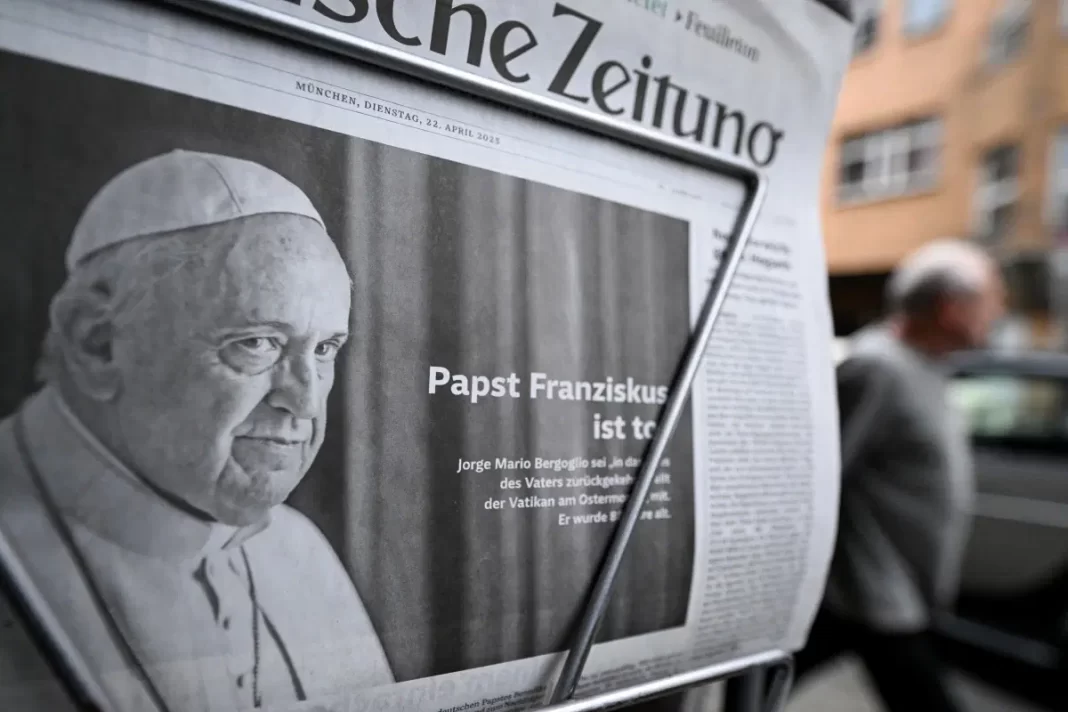On Wednesday, Pope Francis’s open coffin was moved to St. Peter’s Basilica for a three-day lying-in-state, drawing thousands of people who came to pay their respects to the leader of the global Catholic community.
As the wooden coffin was carried in procession through the crowded St. Peter’s Square, the bells of the basilica rang out, while red-robed cardinals and the Vatican’s Swiss Guards accompanied it. Pilgrims and tourists took photos, with some clapping as the procession made its way from the Santa Marta residence, where the 88-year-old Argentine pontiff passed away on Monday following a stroke.
Francis’s body had been held in the Santa Marta chapel, where he lived throughout his 12-year papacy, but will now lie in state at St. Peter’s Basilica until his funeral on Saturday.
Anna Montoya, 33, from Mexico, was among those who arrived early to pay her respects to a man she described as feeling like “a family member.”
“I had to come… it feels like I knew him,” she told AFP. “He was a good man. He embodied what the church should be, what Jesus wanted to teach us.”
Francis’s coffin was placed before St. Peter’s Altar of the Confession, beneath Bernini’s towering bronze baldacchino, which rises toward Michelangelo’s iconic dome. It rested on a simple bier, in contrast to the more elevated and ornate platforms used for previous popes.
The funeral is expected to attract hundreds of thousands of pilgrims, as well as world leaders, including US President Donald Trump, Ukraine’s Volodymyr Zelensky, and Britain’s Prince William.
Afterward, Francis’s coffin will be taken to his beloved church, the papal basilica of Santa Maria Maggiore in Rome, where it will be laid to rest in the ground, marked by a simple inscription: Franciscus. Italy is organizing a significant security operation for the funeral, with the weekend expected to be busy due to the public holiday on Friday. Interior Minister Matteo Piantedosi stated that authorities were anticipating between 150 and 170 foreign delegations, along with tens of thousands of attendees.
Barriers have already been set up both inside and outside the basilica to manage the crowds, security checks have been heightened, and staff have been handing out bottles of water due to the warm weather.
Pasquale Apolito, a 43-year-old teacher from Rome, mentioned that he would be leaving the city later in the day but wanted to catch a glimpse of the pontiff if possible.
“I’m not sure I’ll be able to see the body, but I felt I had to be here today. Something inside me told me to come,” he said. “He was a guide because of his ability to listen and welcome. He will be deeply missed.”
Italy has declared five days of national mourning — longer than the three days observed for Polish Pope John Paul II in 2005, but shorter than the week of mourning declared for Francis by his home country, Argentina.
Following the funeral, attention will shift to the process of selecting Francis’s successor as the leader of the world’s 1.4 billion Catholics.
Cardinals worldwide have already received letters from the Holy See instructing them to return to Rome for the papal election.
Only those under the age of 80 are eligible to vote in the conclave, which must take place between 15 and 20 days after the pope’s death.
On Tuesday, around 60 cardinals, both young and old, gathered in Rome for a “general congregation” to decide on the date of the funeral.

A second meeting is scheduled for Wednesday afternoon, led by the camerlengo, Cardinal Kevin Farrell, who is responsible for overseeing the daily operations of the Holy See until a new pope is chosen.
Francis’s death occurred less than a month after he was discharged from the hospital, where he had spent five weeks battling pneumonia in both lungs.
READ MORE: NPHCDA Reports: Ongoing Polio Transmission in Nigeria
Despite being advised by doctors to rest for two months, Francis continued to make public appearances during his recovery, though he appeared breathless and fatigued.
On Easter Sunday, just a day before his death, he toured St. Peter’s Square in his “popemobile” after mass and his traditional address, greeting the crowds and stopping to kiss babies along the way.
He passed away the following morning at 7:35 am after suffering a stroke, falling into a coma, and experiencing heart failure, as noted in his death certificate.
Sister Maria Guadeloupe Hernandez Olivo, from Mexico, said it was “very hard, very sad” to hear news of his death.
“I did not expect it,” she told AFP in St Peter’s Square. “I believe he’s in a better place, no longer suffering, but I do feel this emptiness for our pastor.”




